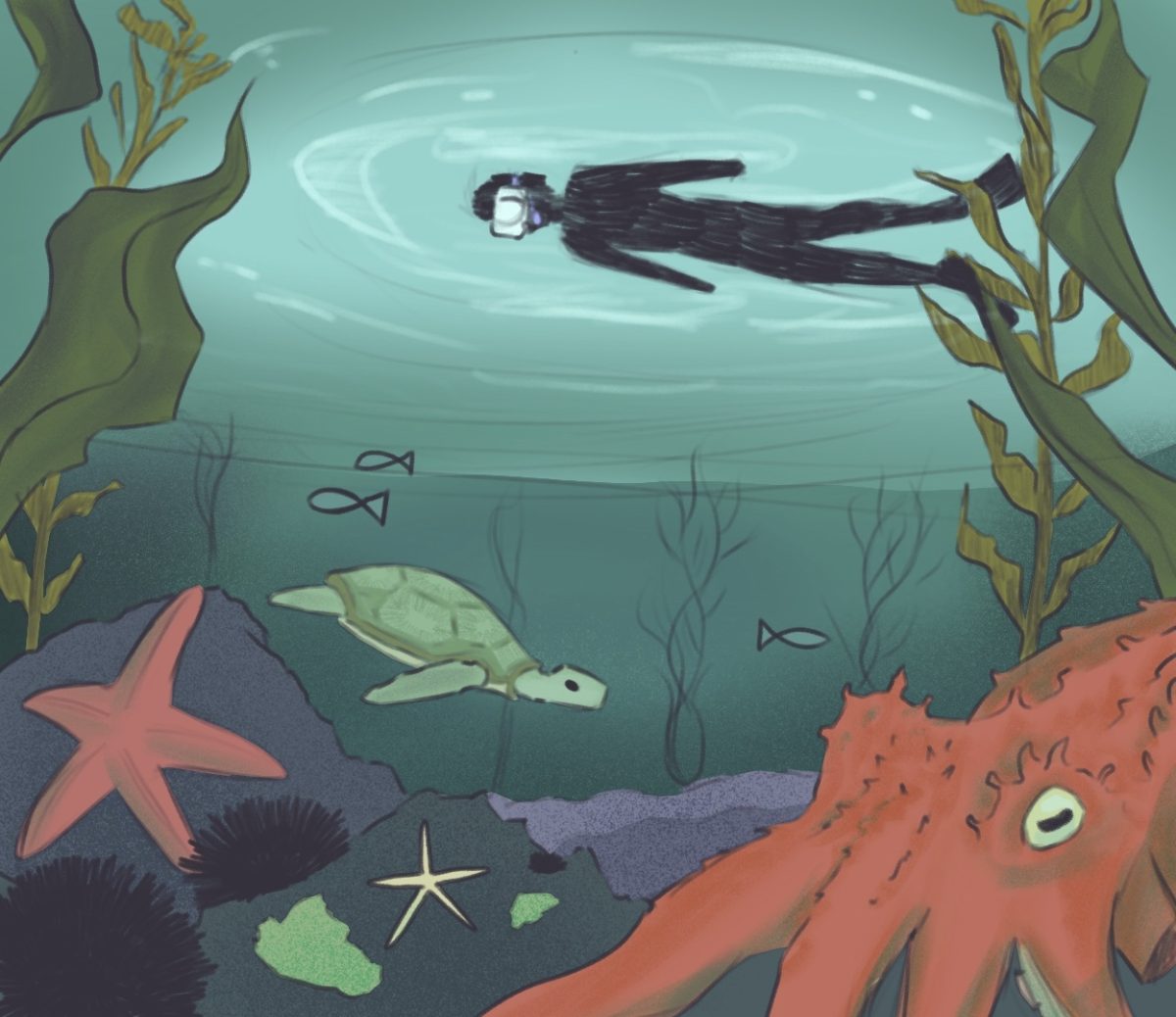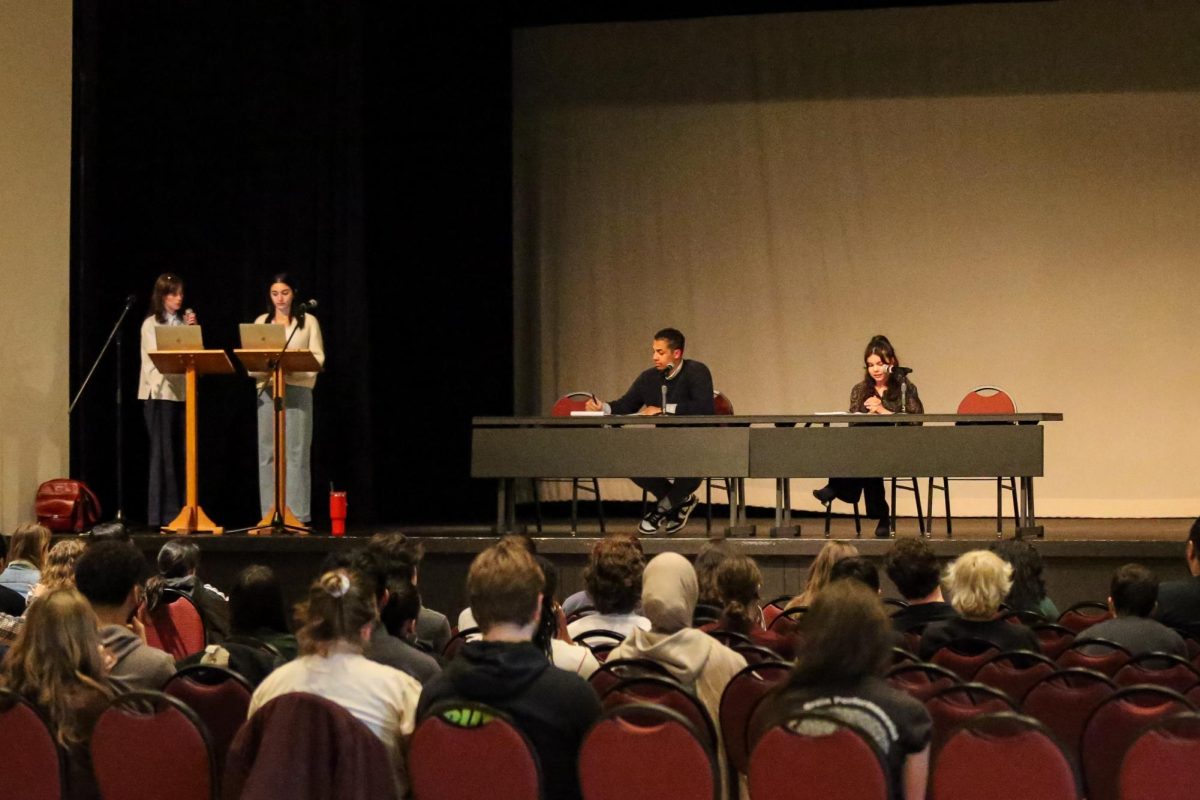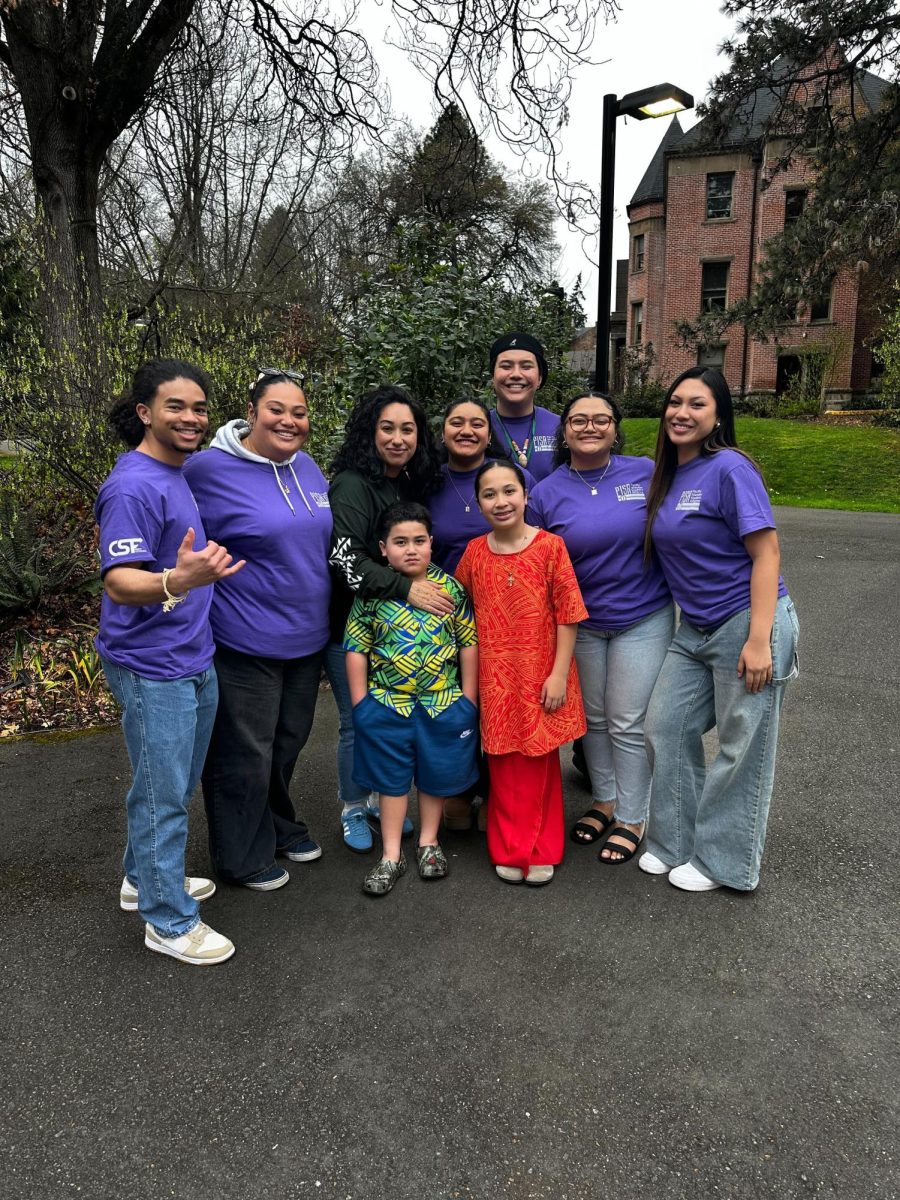In the barren lands of the Eastern Oregon desert, a team of University of Oregon archaeologists, field archaeologists and volunteers sift through dirt, rocks, rain water and 18,000-year-old camel teeth. Hot winds from the south blow through the excavation site in an endless fashion, covering field notes the archaeologists will later use to summarize their findings.
The site where they’re digging up some of North America’s oldest history is tucked well into the desert filled with sagebrush and empty of water. Named Rimrock Draw Rockshelter, the excavation site now feels like home to the community of passionate archaeologists, but was once a temporary home to travelers from more than 18,000 years ago, until 7,600 years ago.
Chuck Morlan has been volunteering his archaeological knowledge at Rimrock Draw Rockshelter since the excavation site was founded in 2011. Today, he still finds himself in six-feet-deep units searching for diamonds – artifacts – in the rough, his dyed purple hair standing out from a distance.

But in 2012, Morlan discovered artifacts that lengthened the history of North America and challenged what historians previously knew about human and natural history on the continent.
A dirty breakthrough
“So as I dug down further and further, I came across this kind of coffee-cream color material in the ground. It would appear, then disappear. So I thought, ‘Hey, this could be tephra,’” Morlan said.
Tephra is volcanic ash. Ash, Morlan explained, has its own chemical signature. Ash from one eruption differs completely from ash of a separate eruption, and each separate ash deposits are given designations – names – to tell each other apart.
The ash that Morlan found on his fateful day in 2012 turned out to be from a Mount St. Helens volcanic eruption 15,300 years ago, designated as Mt. St. Helens S.G.

Morlan figured, with his understanding of the laws of superposition (i.e., how to age layers of sediment), that anything below the Mount St. Helens ash line automatically is dated to be older than 15,300 years. He later “chased out” the line throughout the majority of the excavation site, proving to him and his colleagues that evidence of life before 15,300 years ago was right under their noses.
“So then below that, I came across these platelets. I knew what it was, but I was wondering ‘is this really what it is?’ Well, we found camel teeth fragments,” Morlan said.
Camels originally evolved in North America. The camel teeth fragments Morlan found were from Camelops, which was a genus of camel native to North America before it became extinct about 11,000 years ago at the end of the last Ice Age.
With two great discoveries found within a small chunk of excavation time, Morlan dug more. Ten centimeters below the camel teeth fragments, Morlan found another artifact. This time, his discovery not only pointed to extinct animals that once roamed Eastern Oregon, but the humans who hunted them for survival.
“I found this tool, made out of orange chalcedony,” Morlan said, “And it had bison blood on it.”

Results from a residue analysis of the blood concluded that the bison that was slaughtered had been a Bison antiquus, an extinct species of bison that “makes buffaloes look puny,” according to Morlan.
The tool itself, apart from the Bison antiquus blood, is the oldest stone tool to be discovered in North America at the present, dating to be 18,000-years-old.
In other words, Morlan had just found the oldest evidence of human habitation in North America.
From the future, backwards
About 18,000 years ago during the Pleistocene period, North America was full of grasslands and trees at a lower elevation compared to today. People coexisted with many animals: ground sloths, wild horses, cheetahs and mammoths; along with camels and bison.
The environment of Eastern Oregon at the time was wet, cold and swampy. A river ran through what is now Rimrock Draw, and it was connected to the ancient Lake Bonneville. What’s left of Lake Bonneville today is known as the Great Salt Lake.

Rimrock Draw has no evidence of permanent habitation. Meaning, rather than a village, the site was more akin to a prehistoric roadside rest stop to travelers heading onwards to a warmer, more habitual area.
However, archaeologists and volunteers have unearthed atlatl – a spear throwing device – tips and spear tips similar to Morlan’s big find, further suggesting that the travelers from 18,000 years ago had plenty of animals to hunt and eat in the area.
The team has also found grindstones and stone plates, suggesting that the Native people during this period had a varied diet and an ability to build tools that aided it.
“These people were the same people as us. Hardwired exactly the same,” said Dr. Patrick O’Grady, a staff and research archaeologist at UO. “They just had a different toolkit than we have.”
However, one day, life at Rimrock Draw came to an abrupt end.
Above the 15,300-year-old Mount Saint Helens eruption ash line lies another ash line — the eruption of Mount Mazama 7,600 years ago, which created Crater Lake.
And above the Mt. Mazama line, there is nothing. There is no evidence of animals, teeth, or of human life — just sand, dirt and scattered volcanic stones across the surface.
The erasure of the Rimrock wetland was sudden – one day there was life, the next day there was none. Like a prehistoric Pompeii, Rimrock Draw was bookended by an apocalyptic explosion, represented by a layer of ash dug out by the team of archaeologists.
Re-encounters of the site
Scott Thomas frequented the lands surrounding Rimrock Draw Rockshelter often before it had a name and interest to anyone — besides the Native peoples from long ago.
He worked as an archaeologist for the Bureau of Land Management for more than 20 years. At that point in his career in 2009, Thomas had been supplying O’Grady and his colleagues with water and food at a nearby excavation site.
Driving back and forth from Burns, a nearby town, and the excavation site each day of the field school gave him enough time to examine the land and what might lie beneath it. With each drive, his interest in a specific basalt rim right off the main road continued to tug at him, until he eventually caved and journeyed over to the rim on foot.
What attracted Thomas to the basalt was the tall height of the sagebrush that hugged close to it. Taller sagebrush indicates deep, moist soil, which acts like a neon sign for good finds to archaeologists. The greater accumulation of sediments indicates that a body of water could have previously been located at a site, which is where people have tended to settle throughout history.

And Rimrock Draw showed many signs of being a site with a heavy accumulation of sediments: the tall sagebrush and heavy southwest winds that would blow dirt to the bottom of the rim were the top signs.
When Thomas stepped foot onto the rimrock of what is now Rimrock Draw Rockshelter, he also found an obsidian stem point, a small piece that is attached to an arrowhead. This finding suggested that he hadn’t been the only one to stand where he stood that day.
He told his findings to O’Grady, who, one year later, opened up the field school.
The doctor behind it all
This summer of discovery has been the twelfth for the field school, and one of many for Dr. O’Grady.
Over the course of the field schools, O’Grady’s teams have made discoveries that have pushed the history of North America further back than previously known.
But the excavations at Rimrock Draw might come to a close soon, O’Grady said.

“I plan to have this be the last year of excavation out here because I want to preserve as much as the site for the future,” he said. “And also, I need to start writing.”
Through the many years spent excavating the site, O’Grady recalls his favorite memories to be the ones where he helped teach students how to excavate and understand archaeology at a complex level.
O’Grady, while being interviewed, was simultaneously helping a student at a sifting screen who found an object and had trouble identifying it. She asked O’Grady for help. He smiled, examined the piece and within a minute was able to identify it as a marmot tooth. He handed the tooth back, providing in-depth explanations that led him to his conclusion. The student thanked him, and he patted her on the back, applauding her for the find.
The team of students, archaeologists and volunteers all attested to the positive and engaging environment that O’Grady has helped create at Rimrock Draw.
“Pat and Chuck have been teaching us a lot of different things,” said Danger Addams, an undergraduate student at UO studying geochemistry. Addams recounted learning from O’Grady and Morlan the different tool types to use while excavating and what the tools they dug up are made out of, and has been taught many in-depth history lessons by O’Grady.
When Addams has felt overwhelmed by the high-level of excavations at Rimrock Draw, O’Grady and supervisors like Tom Tandberg, a student who graduated with a degree in humanities from UO in 2022, will “meet you where your worries are at.”

A rock-solid community
When not excavating for some of the oldest artifacts in North America, the archaeologists at Rimrock Draw flock to the shade of the rimrock, listening to older country music and talking amongst themselves.
Almost every meal is cooked together, the menu ranging from burritos to hashbrowns.
“Cooking and eating together becomes an integral part of how they bond, and that’s just really cool,” O’Grady said. “With other field schools, the whole after-work experience is separate from everybody. This here is just very communal.”
A quick drive away from the site lies their camp, which is situated on a hill overlooking the desert and underneath larger trees.
Finley Brake, a graduate from UO’s humanities department in 2007, said the first initial field trips from camp were over to the field site, where he and his team were given lessons by O’Grady about the history, ecology, geology and topography of the area. When they finally reached the excavation site, he got goosebumps from the sheer amount of history before them.
Brake said that some of the friendships he’s made at Rimrock Draw will last far beyond the field school, and that “we’re all talking to each other about what the next steps are for jobs and career paths.”
History takes on a new meaning
The “pre-Clovis” finds like the ones at Rimrock Draw, which were once out-of-the-ordinary, are ushering in a new frontier in American archaeology. Not far from Rimrock Draw, excavations at Oregon’s Connley Caves and Paisley Caves – both affiliated with UO – have also yielded pre-Clovis finds.
However, archaeologists such as O’Grady are hesitant to date such materials earlier than the speculated human arrival across the Bering Strait, the land bridge which opened up Asia to North America and became passable by humans around 15,000 years ago.
“There’s a lot of people who don’t want to believe that there’s anything older than Clovis. And it’s something that’s pervasive in archaeology,” O’Grady said. “There’s just a lot of people that won’t accept the new data. How do you argue with that? You really can’t.”
But the possibility of human habitation in North America 18,000 years ago still manages to raise profound questions about the history of human settlement of the Americas.
The Rimrock Draw findings could mean that people lived in Oregon over three thousand years before the Bering land bridge opened up. This means that the Bering Strait might not have been the first method by which humans entered the Americas. They might have entered earlier.
This raises new questions from archaeologists and historical scientists. How might have people entered North America earlier than 18,000 years ago? Could they have migrated to North America during a warm interglacial period even earlier, before 30,000 years ago?
Ultimately, O’Grady says, his job as an archaeologist is to work with the evidence he or his team has found. “When I work in a place like this, I just want to talk strictly about the physical information we’re getting from this site. Because beyond that, it’s just conjecture,” he said.
Looking back
The significance of the findings at Rimrock Draw not only weighs heavily on North America’s history, but on the volunteers and archaeologists who initially found the artifacts.
For Morlan, the meaning behind his excavations have been about “adding to the knowledge of your and my heritage. [Finding these artifacts] will never happen to me again and I’m so glad to be a part of it,” he said.
Morlan worked as an elementary-school teacher for 20 years. He worked with the Bureau of Land Management for roughly nine years, but said being included in projects with O’Grady, such as Rimrock Draw, has made him a “very, very lucky person.”
O’Grady said working at Rimrock Draw – or any excavation site – means having the ability to “keep working and waiting,” and highlighted the importance to “surround yourself with people who help you learn.”
For him, the team of students, professionals and volunteers are the ones who made the site what it is. “It’s community,” he said.








